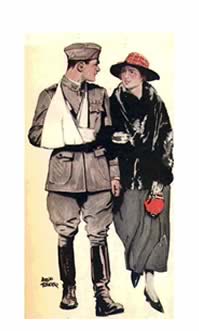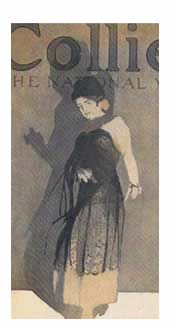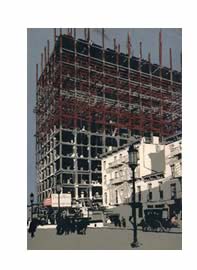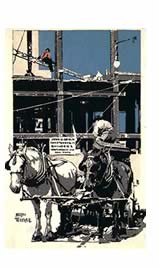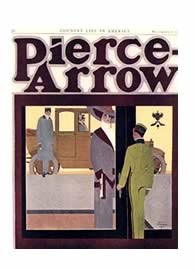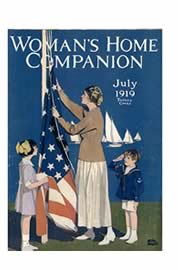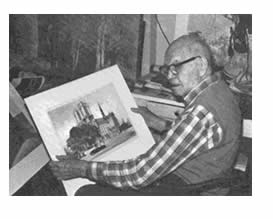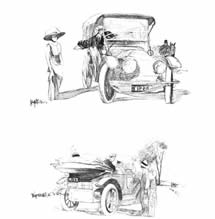 a few more a few more
Some Autobiographical details.
Treidler came to Chicago, en route for New York. in 1906 He spent 18
months there, beginning with fashion illustrations. His employers
never gave him the proofs, ensuring he didn't have a portfolio with
which to apply for other jobs. He worked for the Chicago Tribune
at a pittance, not knowing to ask the proper wage at the beginning.
He arrived in New York and settled into Madison Square area, making
early contact with Calkins and Holden, and their art director, Walter
Whitehead. Early work was paid at thirty dollars a day. "At that time Scribner's, The Century, McClure's,
Munsey's all those magazines were published in that area....I could take
my samples to three places on one block... I started making up New York
samples. I had never seen a hansom cab and hardly ever been in an automobile.
I decided to make a drawing with a hansom cab in it. There were a few
cars and a lot of hansom cabs at Madison Square and that was the first
sample I made to try and get work in New York." In one of his drawings
he included a Pierce Arrow car, and Whitehead had just started handling
that account. That's how it all started."
The war started him as a poster artist. In 1916 he won the Newark 250th
foundation celebration poster and established a national reputation. He
was not paid for war posters.
"I never did much liked story illustration . A little bit... I liked
scenery and and I liked travel..." He began with some spot illustrations
for catalogues, but the main work for Pierce Arrow started in 1928. He
used his own images for reference rather than the company's own."I
went out in a car and took my own photographs. I could have had photographs
and I probably did at some time, but the photographs were all, you know,
conventional views such as they used in the catalogs, and they weren't
much use to me. "
Treidler was also celebrated for his series of magazine covers for Colliers
magazine. He met the editor Albert Lee who commissioned six covers
at three times what he was normally paid. From 1930, he worked mainly
on marine and holiday images for the French Line (and their agents
Ayers of Chicago). He also painted murals in the head offices of
the French Line. In his later years he turned from commercial illustration
to paint purely for his own pleasure. He died in 1982.
|
Through the magazine collector Bob Reed, I came across more information
about Adolphe Treidler and the development of American commercial art.
Bob had known the man and made available to me much information, mostly
gleaned from Pierce Arrow sources. My thanks to Bob Reed for this and
his immense hospitality. From the 1930's Treidler had been seen as the
great American poster artist, to be mentioned in the same breath as the
Beggarstaffs and Steinlen. After 1945, his reputation seemed to have declined
except among graphic design enthusuasts and the admirers of Pierce Arrow
cars with whom Treidler was most associated.
Treidler produced prints of urban life and I show two undated examples
showing a favourite theme - the construction of the city. The prints show
a command of drawing, derived in places from photographic reference, and
a love of intricate surface pattern often from cast shadows.
|
Magazine and Press
Work
A note on Treidler's use of photography in designing, here for a poster,
from Gene Byrnes, A Complete Guide to Drawing , Simon & Schuster,
New York 1948; "Mr.Treidler considers the photograph useful in establishing
size relations, such as the figures to the boat. The elements are then
studied in a colour sketch to determine good relationships in the proportion
of color, shapes and sizes of various flat areas in the design. When this
is done, a careful drawing is made in outline, defining each area of color.
These outlines disappear as the color is painted in...." p.324.
SPOT ILLUSTRATIONS FOR PIERCE ARROW PRESS ADS.
detail from the cover of HOLIDAY magazine December 1930 of the Train Conductor.
detail from the cover of Collier's magazine January 11th 1919, 14 x 25cms
detail from the cover of Collier's magazine March 25th 1911, 13 x 24cms
another illustrator
associated with Pierce Arrow - Louis Fanchon.
 IN THE PUBLIC DOMAIN IN THE PUBLIC DOMAIN
 interview, Pierce Arrow Society interview, Pierce Arrow Society
 A LIVING LEGEND A LIVING LEGEND
 CAR COLLECTOR CAR COLLECTOR
|





